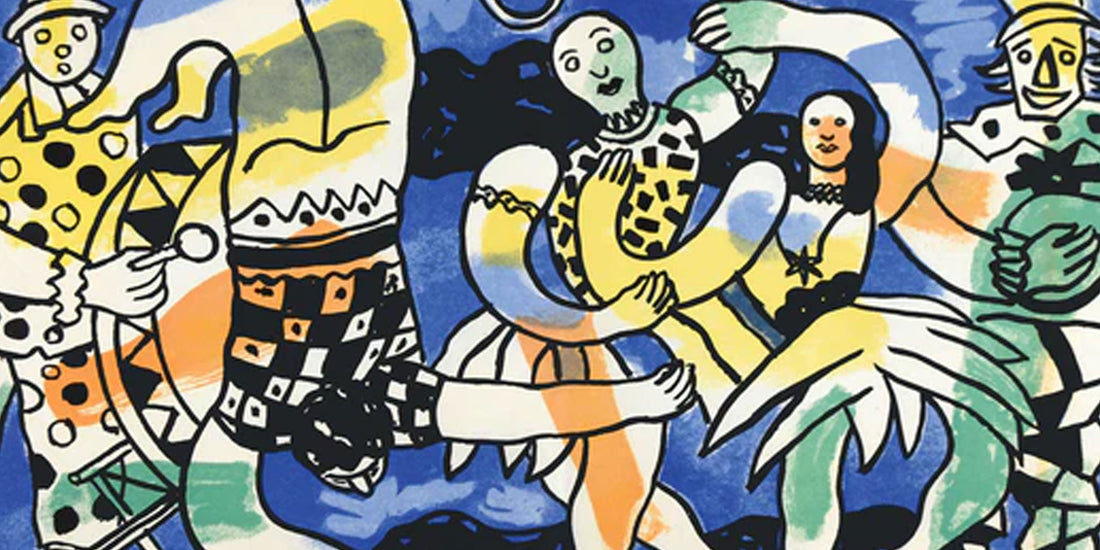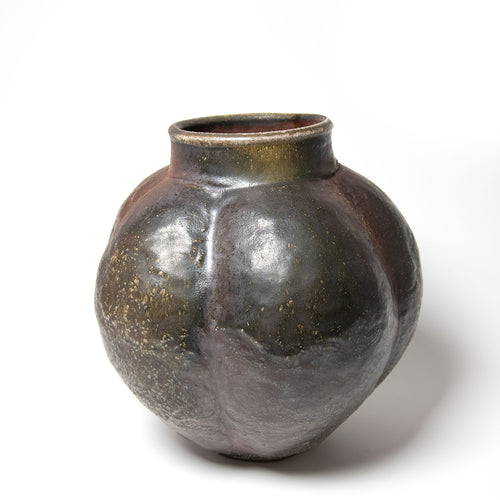
harlequin 'Commedia dell'Arte' performers by Alfred Cohen
Historically, the circus had grown from the theatrical features of the old Italian Commedia dell’Arte, the British harlequinade and French saltimbanques. It was, for a long time, essentially a rural touring show: ringmasters would have their sets put up on the outskirts of towns and villages, while performers drummed up local business with free sideshows, temporary stands outside the main tent where performers offered sneak peek routines from their upcoming acts. As suburban areas grew, cities sprawled, and modern-day life became increasingly busy, these outskirt shows were forced to offer ever-more impressive performances to woo their crowds. Before long, the traditionally travelling showmen looked to set up permanent structures in which even greater acrobatic acts and wild animal processions could be accommodated. Around the peripheries of Paris, land was bought and big-tops were erected, most famous of all the Cirque Fernando.

whirligig acrobats and trapeze artists in Fernand Léger's 'Cirque' suite
The circus offered obvious visual delights to the city’s artists. From swooping, spangled trapeze artists to equestrienne acts, its shows presented dynamic scenes full of loud colour and whirling motion. Even the crowds, a sea of expressions from all walks of life, held painterly potential; its multicolour, pick-and-mix assortment of pink faces, feathered hats, patterned clothes and dancing performers must have had a profound impact on the development of ‘divisionism’, the Neo-Impressionist pointillist style made famous by Seurat (himself a keen Fernando attendee).
Established in the late 1870s and situated on the border of the old city, just outside the artists’ quarter in the district of Montmartre, the Cirque Fernando became the first choice of nearby painters and sketchers, from Degas and Renoir to Toulouse-Lautrec. Many befriended particular performers and negotiated free entry to big-top shows, a tradition that was to remain at Fernando’s well into the 20th century. A Fernando clown - Clovis Sagot – even retired to become an art dealer, having become acquainted with the many painters who frequented his performances.

Toulouse-Lautrec's 'Clownesse Assise' presents an intimate backstage portrait
The proximity of Fernando’s to the usual haunts of the Bell Epoque set meant that, with time, they came to experience the behind-the-scenes environment of the circus too. If it was the pageantry of colour and physical prowess that first drew them to paint and draw these performers, it was sympathy for their hidden lives that kept them coming back, and which grounded their depictions of high-wire performances in a kind of early, gritty social realism. Though now permanent structures, the circuses of Paris were still very much spaces on the margins of the city: they existed in ‘liminal’ spaces, caught on boulevard corners between districts. Like their traveller predecessors, circus performers skirted the edge of accepted society.

Bernard Buffet's melancholic elephant, a metaphor for the outcasts of the big-top
Many of them were members of distinct minorities – black immigrants, disabled or disfigured ‘aberrations’, performers who in private were sexually ‘deviant’ or the victims of childhood trauma. To keep public audiences returning, they were required constantly to innovate routines, change personas, and pursue more dangerous stunts of derring-do. The trope of the sad clown – the exhibitionist performer who invests every ounce of his energy in entertaining his audience, but who is himself empty of the mirth he projects on stage – was already firmly established by the turn of the century. In the circus, some artists saw a reflection of their own suffering; of the emotional solitude of the artistic soul, disaffected and estranged from the rest of society.

By the 1900s, the Cirque Fernando had undergone significant changes as it struggled to keep up with the pace of modern industrialisation. After its last remaining family member nearly ran the circus into the ground, it was saved from bankruptcy by one of its own performers – Gerónimo Medrano, an ex-clown by the name of ‘Boum Boum’ who bought the big-top’s lease and renamed the circus after himself. The Medrano family were responsible for modernising their shows in light of the increasing competition from cinema and radio for audiences’ attention. In the interwar years they looked to hire back performers who had left circus life behind for the spotlight of variety stages and music hall, such as the famed clown Grock. Celebrity appearances from the likes of Buster Keaton kept ticket sales high, and the circus enjoyed a boom of trade at a time when it was becoming more and more difficult to sustain a ring in Paris’ prime real estate.

George Rouault's 'Weary Bones' clown portrait
Many of the greats of 20th century art visited shows and took inspiration from Medrano’s electrifying performances. For all their sumptuous colour, from dusty crimson to mustard yellows, Rouault’s Cirque de l'Étoile Filante (Circus of the Shooting Star) aquatint etchings expose the melancholy of life in the troupe, a sadness made all the more poignant by its superficial cheer.

Chagall's joyous circus performer pirouettes on the back of a horse
Not all artists zeroed in on performers’ despondency or poverty: to Chagall, the circus became an emblem of dancing joy, full of whirligig acrobats leaping from prancing horse to swinging trapeze. Perhaps most celebratory of all was Léger, who found in the ring and its hurtling ensemble a metaphor for life and the vitality of the countryside. In Cirque, Léger’s magnum opus as a printmaker, he compared circus performance with riding a bike through woods and fields, writing of the primacy of the round and the curve in nature and finding ‘nothing as round as the circus’. Accompanying his text was a series of lithographs in which bright colour abounds, contained only by Léger’s vigorous black line. Arabesques of birds and spinning performers become symbols of spontaneity, their circular motion representative of the ‘dance’ of life.

Ultimately, the circus made accessible to local artists a carnival of colour and movement that offered an ironic blank canvas. Unlike the theatre or ballet, or, outside the performative sphere, modern and classical literature, the circus was a primarily physical experience: it championed feats of strength and agility over intellectual depth, and in its spectacular ease appealed to a far wider audience. Onto its visual feast artists could project a multitude of personal readings, interpretations of each show that were alternately festive and forlorn.

double-page spread from Matisse's 'Jazz' suite; the series was originally called 'Cirque'
It is telling how many who did attend performances would rework the shapes and figures of the circus into images of self-deception and autobiography: from Toulouse-Lautrec, who drew clowns and acrobats from memory to prove his own sanity while recouping from his rampant alcoholism in an infirmary; to Matisse, whose Jazz suite, a last hurrah in 1947, saw the artist creating cut-out images of twirling, twisting performers even as he sat immobile in a wheelchair, after an operation from which he would never fully recover.

Léger's ringmaster and horse, from the 'Cirque' suite
The illusory grandeur of circus life and its many marvels gave something for these artists the cling to; it was the embodiment of a dichotomy between momentary elation and hidden melancholy, between pure happiness and debilitating sadness. The big-top, with its bright lights, held a mirror to the artist’s soul.










